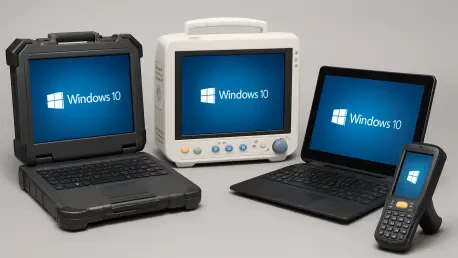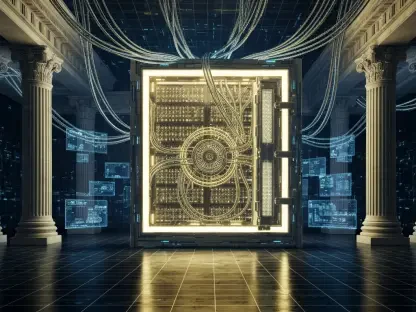As technology races forward with ever-evolving operating systems, a significant number of critical industries find themselves tethered to older software, particularly in healthcare and industrial sectors where the stakes of system compatibility and security are extraordinarily high. The looming end-of-life for Windows 10 has placed immense pressure on organizations to transition to Windows 11, yet many are grappling with insurmountable barriers. Compatibility issues with specialized hardware, exorbitant costs of upgrades, and the complex nature of validation processes in regulated environments have created a perfect storm of challenges. This situation raises pressing questions about how industries reliant on legacy systems can balance operational continuity with the need for modern cybersecurity. Delving into these hurdles reveals a landscape where technical limitations and financial constraints collide, leaving many sectors at a crossroads as they navigate the risks of outdated software against the impracticalities of immediate upgrades.
Challenges in Upgrading Critical Systems
Hardware and Software Incompatibility Barriers
In sectors like healthcare and manufacturing, the inability of existing hardware to support Windows 11 stands as a formidable obstacle to modernization. Many devices, such as industrial computers and medical equipment, were designed with processors and configurations that fall short of the new operating system’s stringent requirements. This mismatch forces organizations to confront a harsh reality: either invest heavily in new hardware or remain on unsupported systems. The financial implications are staggering, especially when considering that some medical devices, integral to patient care, are tied to specific software versions that vendors have not certified for Windows 11. This lack of certification often stems from the complexity of revalidating software in highly regulated environments, where even minor changes can trigger lengthy testing protocols to ensure safety and compliance. As a result, the path to upgrading becomes not just a technical challenge but a logistical and regulatory minefield that slows progress to a crawl.
Beyond the hardware itself, the software ecosystem surrounding these devices adds another layer of difficulty to the transition. Clinical and industrial applications are often deeply integrated with the operating system, meaning any upgrade requires extensive compatibility checks. Suppliers frequently hesitate to update their software for Windows 11 due to the costs and resources involved, leaving end-users stranded. In some cases, vendors view the connected computers as inseparable from the equipment, necessitating expensive professional services for even minor updates. This creates a vicious cycle where the fear of disrupting critical operations deters upgrades, yet staying on Windows 10 poses long-term security risks. The tension between maintaining stability and embracing necessary advancements is palpable, as organizations must weigh the immediate costs against potential vulnerabilities that could emerge once support for the older system officially ends.
High Costs of Transitioning Equipment
The financial burden of upgrading to Windows 11 often proves prohibitive for organizations in specialized sectors, where the cost of replacing or updating equipment can run into the hundreds of thousands or even millions of dollars. For instance, in healthcare, replacing a single MRI scanner or X-ray machine that lacks compatibility with the new operating system represents a massive investment, far beyond the budget of many facilities. Even when upgrades are possible, suppliers may quote exorbitant fees for adapting existing devices, further straining financial resources. This economic reality forces many institutions to delay transitions, opting instead to maintain older systems despite the looming risks. The challenge lies not only in funding these upgrades but also in justifying the expense when budgets are already stretched thin by other operational demands and priorities.
Moreover, the cost issue extends beyond hardware to encompass the hidden expenses of downtime and retraining staff on new systems. Upgrading critical devices often requires taking them offline, which can disrupt workflows in hospitals or production lines in factories. Such interruptions carry a direct impact on service delivery and revenue, adding to the overall price tag of modernization. Additionally, employees accustomed to Windows 10 must adapt to a new interface and potentially altered software functionalities, necessitating training programs that consume time and resources. These ancillary costs compound the direct financial hit of purchasing new equipment or software licenses, creating a scenario where the total investment required for a full transition becomes daunting. For many organizations, the question becomes whether the security benefits of upgrading outweigh the immediate and long-term financial strain of such a monumental shift.
Sector-Specific Struggles and Solutions
Healthcare Sector’s Unique Upgrade Dilemmas
In the healthcare industry, the stakes of transitioning to Windows 11 are uniquely high due to the critical nature of medical devices and the stringent regulations governing their operation. Hospitals and clinics often rely on specialized equipment like diagnostic tools that operate within isolated networks to ensure security and compliance. Upgrading these systems to a new operating system involves not just technical adjustments but also rigorous validation processes to confirm patient safety and data integrity. Many clinical software providers are slow to certify their applications for Windows 11, leaving healthcare providers in a bind. Without certification, using the new OS risks non-compliance with health regulations, yet remaining on Windows 10 opens the door to potential security breaches as support wanes. This delicate balance between regulatory adherence and cybersecurity needs creates a complex puzzle for healthcare administrators to solve.
Adding to the challenge, the cost of replacing non-compatible medical equipment often reaches prohibitive levels, forcing tough decisions about resource allocation. Some healthcare trusts have made strides in upgrading general systems but hit roadblocks with specific devices that cannot support the new OS without significant investment. The alternative—purchasing entirely new equipment—carries a price tag that can cripple budgets, especially for smaller facilities. Temporary workarounds, such as extended support for Windows 10 through specialized editions, offer a reprieve, but they are not permanent solutions. The healthcare sector thus finds itself navigating a tightrope, where the immediate impact of an unsupported OS may be mitigated by third-party security services, yet the long-term risks of outdated systems loom large. This ongoing struggle underscores the need for tailored strategies that address both the technical and financial dimensions of the upgrade challenge in medical environments.
Industrial and Maritime Sector Delays
The industrial sector faces its own set of hurdles in moving away from Windows 10, primarily due to legacy hardware that cannot meet Windows 11’s requirements. Many industrial computers, used for controlling manufacturing processes, rely on outdated processors that are incompatible with the newer OS. This hardware limitation means that entire systems may need replacement rather than a simple software update, driving up costs and complicating implementation timelines. Vendors in this space often prioritize stability over innovation, meaning support for modern operating systems lags behind consumer-grade technology. As a result, factories and plants risk operating on unsupported systems, which could expose them to cybersecurity threats in the future. The slow pace of adaptation in this sector highlights a broader trend of resistance to change when operational continuity is paramount.
Similarly, the maritime industry lags significantly in adopting Windows 11, with research indicating that nearly half of all vessels have yet to make the switch. Shipboard systems, critical for navigation and communication, often run on older software due to the unique environmental and operational constraints of maritime settings. Upgrading these systems poses not only technical challenges but also logistical ones, as vessels may need to be docked for extended periods to implement changes. The potential cybersecurity risks of remaining on Windows 10 are a growing concern, especially as cyber threats targeting critical infrastructure become more sophisticated. While some temporary measures, like third-party support, can mitigate immediate risks, the maritime sector must eventually confront the need for modernization. Both industrial and maritime environments illustrate how sector-specific demands can delay technological progress, leaving critical operations vulnerable over time.
Navigating Future Pathways
Reflecting on the struggles faced by various sectors, it becomes evident that the transition from Windows 10 to Windows 11 is fraught with technical incompatibilities and financial burdens that demand strategic responses. Healthcare facilities wrestle with the dual pressures of regulatory compliance and patient safety, often postponing upgrades due to the astronomical costs of new equipment. Industrial and maritime sectors, meanwhile, grapple with legacy hardware and operational constraints that slow their adoption of modern systems. Temporary solutions, such as extended support for Windows 10 through specialized editions, provide a buffer against immediate security risks. Looking ahead, organizations must prioritize developing long-term strategies, such as phased upgrade plans or partnerships with vendors to certify software for Windows 11. Investing in scalable, future-proof hardware could also ease transitions down the line. As the landscape of cybersecurity evolves, proactive collaboration between industries and technology providers will be essential to safeguard critical systems against emerging threats.









